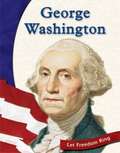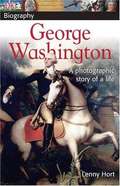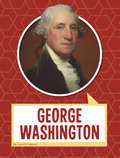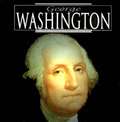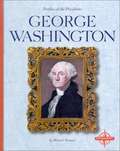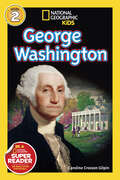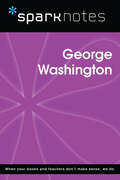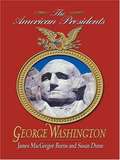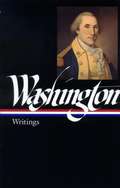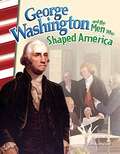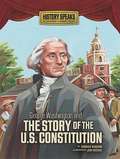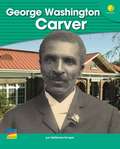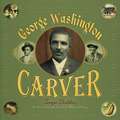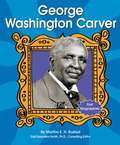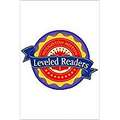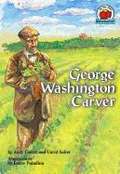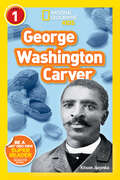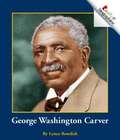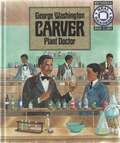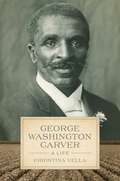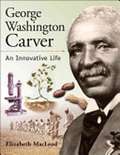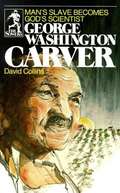- Table View
- List View
George Washington
by Kristin Thoennes KellerFollows the life of the revered leader George Washington. Covers Washington's childhood on a farm and his early lessons on being a gentleman to his experience in the French and Indian War, his military leadership in the Revolutionary War, and finally, his role as first President of the United States.
George Washington
by Lenny HortGeorge Washington is often called the father of our country. He beat the odds to lead the Continental Army to victory in the Revolutionary War, served as first president of the United States, and then retired from public life to farm Virginia's largest plantation. In this groundbreaking new series, DK brings together fresh voices and DK design values to give readers the most information-packed, visually exciting biographies on the market today. Full-color photographs of people, places, and artifacts, and sidebars on related subjects add dimension and relevance to stories of famous lives that students will love to read. Modern scholarship and a variety of narrative approaches give today's reader a chance to explore the extraordinary worlds of George Washington and Abraham Lincoln. This new way of looking at classic subjects creates a unique reading experience that breathes life into the book-report and summer-reading repertoire.
George Washington
by Tom McgowenRecounts the life of America's first president, including his youth in Virginia, military career, role in the formation of an independent nation, and leadership of that new country.
George Washington (Biographies)
by Laura K. MurrayHow much do you know about George Washington? Find out the facts you need to know about the 1st president of the United States. You'll learn about the early life, challenges, and major accomplishments of this important American.
George Washington (I Am #5)
by Grace Norwich Anthony VanArsdaleGet to know the humble Revolutionary War general who became the first U.S. President!They said I was a leader, brave, honest, fearless, and just. My thoughts of myself were much more modest. Some Americans wanted to make me a king instead of a president. I refused because I knew that the strength of the United States and the value of liberty were more powerful than any one person—even me. I am George Washington.Celebrated war hero George Washington used his progressive ideals to become the first President of the United States, earning the nickname “Father of his Country.” Young readers will be inspired by Washington’s heroic journey to make America a better place in this biography featuring: illustrations throughouta timelinean introduction to the other people you’ll meet in the book, including Helen’s amazing teacher and the men who fell in love with hermapssidebarsa top ten list of important things to know, and more
George Washington (Photo-illustrated Biographies Ser. #4)
by T. M. UselA short biography of George Washington, the Virginia farm boy who grew up to lead the American army in the Revolutionary War and become the first president of the United States. Pictures are described.
George Washington (Profiles of the Presidents)
by Michael BurganA biography discussing the personal life, education, and political career of the first President of the United States, George Washington.
George Washington (Readers Bios)
by Caroline Crosson GilpinLearn all about George Washington, one of the most important figures in American history, in this colorful, inviting, and entertaining biography. This carefully leveled reader is written in an easy-to-grasp style to encourage the historians of tomorrow!National Geographic supports K-12 educators with ELA Common Core Resources.Visit www.natgeoed.org/commoncore for more information.
George Washington (SparkNotes Biography Guide)
by SparkNotesGeorge Washington (SparkNotes Biography Guide) Making the reading experience fun! SparkNotes Biography Guides examine the lives of historical luminaries, from Alexander the Great to Virginia Woolf. Each biography guide includes:An examination of the historical context in which the person lived A summary of the person&’s life and achievements A glossary of important terms, people, and events An in-depth look at the key epochs in the person&’s career Study questions and essay topics A review test Suggestions for further reading Whether you&’re a student of history or just a student cramming for a history exam, SparkNotes Biography guides are a reliable, thorough, and readable resource.
George Washington (The American Presidents Series)
by James Macgregor Burns Susan DunnIn this thoughtful and incisive biography, the strengths and weaknesses of Washington's presidential leadership are dissected, from his lasting foreign and economic policies to his polarizing denunciation of political parties and his public silence about slavery. The result is a surprising portrait of the multidimensional man behind the myth he so assiduously crafted.
George Washington - Writings
by George Washington John RhodehamelThis one-volume collection - the most extensive and authoritative ever published - covers five decades of Washington's astonishingly active life and brings together over 440 letters, orders, addresses, and other writings.
George Washington And The Men Who Shaped America (Social Studies: Informational Text Ser.)
by Torrey MaloofWith the George Washington and the Men Who Shaped America e-Book, students will learn more about the commander and the leader who helped others found America. This rigorous informational text profiles the first president of the United States of America, during his early days in Mount Vernon, as he gains experience during the First and Second Continental Congress, and as he wins the war. This text also looks at the significant men who aided in the war effort – from Paul Revere, Nathan Hale, Baron von Steuben, and Marquis de Lafayette. Spark a curiosity with primary source materials that offers significant clues on how people lived back then. Build literacy and subject content knowledge with this nonfiction reader that explores US history, geography, and other social studies topics. The George Washington and the Men Who Shaped America e-Book provides access to every type of learner with appropriately leveled content. The reader contains text features such as captions, bold print, glossary, and index to increase understanding and build academic vocabulary. Aligned to McREL, WIDA/TESOL, NCSS/C3 Framework and other state standards, this text readies students for college and career readiness.
George Washington And The Story Of The U. S. Constitution
by Candice Ransom Jeni ReevesIn 1787, the newly established United States was in trouble. The central government had too little power and too little money. George Washington, Benjamin Franklin, and fifty-three other delegates gathered in Philadelphia, Pennsylvania, to find a way to solve these problems. After more than three months of work, the delegates, led by George Washington, had created the U. S. Constitution. It was finished on September 17, which is now celebrated as Constitution Day.
George Washington Carver
by Tonya BoldenA Coretta Scott King Honor Award author offers a fresh look at this pioneering American innovator Shampoo from peanuts? Wallpaper from clay? Ink from sweet potatoes? Discover Carver's imagination and inspiration in this one-of-a-kind biography. With imagination and intellect, George Washington Carver (1864-1934) developed hundreds of unexpected products from everyday plants. This book reveals what an exceptionally uncommon man Carver was: trailblazing scholar, innovative scientist, pioneering conservationist, and impassioned educator. This book follows his life from slave and orphan to his college days as the first African American to attend Iowa State College (where he later taught), and on to his life and work in the field of agriculture. Illustrated with historical artifacts and photographs, the book traces Carver's life, discoveries, and legacy.
George Washington Carver (First Biographies)
by Martha RustadSimple text and photographs introduce the life of George Washington Carver.
George Washington Carver (Houghton Mifflin Reading Leveled Readers)
by Mark TaylorGeorge Washington Carver was an African American scientist. What kinds of things did he invent? Read the story to find out.
George Washington Carver (On my own biography)
by Andy Carter Carol SallerThis book recounts the life of the African-American agriculturist at the Tuskegee Institute, emphasizing his love of plants and his belief in living in harmony with the natural world.
George Washington Carver (Readers Bios)
by Kitson JazynkaTake a bite into the fascinating history of peanut butter and the man who invented it. Through leveled text and engaging photos, kids meet George Washington Carver and learn about his important work with peanuts and other plants. This level 1 reader is carefully leveled for an early independent reading or read aloud experience, perfect to encourage the scientists and explorers of tomorrow!
George Washington Carver (Rookie Biographies)
by Lynea BowdishAn introduction to the life of the African American scientist who overcame great hardship to make unusual and important discoveries in the field of agriculture.
George Washington Carver for Kids: His Life and Discoveries, with 21 Activities (For Kids series)
by Peggy ThomasGeorge Washington Carver was born into the violent era of slavery, yet he had big ideas. The first was to get an education. That meant leaving his Missouri home at a young age, washing people’s clothes to pay for school, moving from town to town, and fleeing a lynch mob. Carver’s second big idea was to serve others. After becoming the first black graduate from Iowa Agricultural College, Carver took a teaching position at the Tuskegee Institute founded by Booker T. Washington. There he witnessed the miserable conditions of the poor Southern farmer. That’s when his ideas began to flow. Carver taught farmers how to nourish the soil, conserve waste, and feed their families. He developed hundreds of new products from the sweet potato, peanut, and other crops, and his discoveries gained him a place in the national spotlight. Throughout the Jim Crow era, Carver toured America speaking about agriculture, but most people went away with a more important message: that every citizen has hidden potential that, like a seed, just needs nurturing to bloom. Many of Carver’s ideas took a long time to develop, but today his concepts of conservation, zero waste, and plant-based products are on the cutting edge of science. George Washington Carver tells the inspiring story of this remarkable American scientist. It includes a time line, resources for further research, and 21 hands-on activities to better appreciate Carver’s genius.
George Washington Carver, Plant Doctor (Real Readers)
by Mirna BenitezA biography of the agriculturist for beginning readers, chronicling his struggle to get an education, his work at the Tuskegee Institute, and how he helped popularize peanuts as a cash crop in the South.
George Washington Carver: A Life (Southern Biography Series)
by Christina VellaChristina Vella received a PhD. in Modern European and U.S. history from Tulane University, where she is a Visiting Professor. A consultant for the U.S. State Department, she lectures widely on historical and biographical topics.Nearly every American can cite one of the accomplishments of George Washington Carver. A national monument bears his name, a U.S. coin was minted in his honor, and his induction into the National Inventors Hall of Fame is one of many tributes honoring his contributions to scientific advancement and black history. Born into slavery, Carver earned a master’s degree at Iowa State Agricultural College and went on to become the university’s first black faculty member. His research into peanuts and sweet potatoes—crops that replenished the cotton-leached soil of the South—helped lift multitudes of sharecroppers out of poverty. When he died in 1943, despite living during a period of systemic racial prejudice, millions of Americans mourned the passing of one of the nation’s most honored and beloved scientists. Scores of children’s books celebrate the contributions of this prolific botanist, but his personal life, his romantic interests, and the intersection of both with his professional career have remained largely unexamined until now.Christina Vella offers the most thorough biography of George Washington Carver, including in-depth details of his personal relationships with family, colleagues, lovers, and friends, set in the context of the early twentieth century. Despite the exceptional trajectory of his career, Carver was not immune to the racism of the Jim Crow era or the privations and hardships of the Great Depression and two world wars. Yet throughout the tumult of this period, his scientific achievements aligned him with equally extraordinary friends, including Teddy Roosevelt, Mohandas Gandhi, Henry A. Wallace, and Henry Ford.In pursuit of the man behind the historical figure, Vella discovers an unassuming intellectual with a quirky sense of humor, striking eccentricities, and an unwavering religious faith. She explores Carver’s anguished dealings with Booker T. Washington across their nineteen years working together at the Tuskegee Institute—a relationship so fraught with jealousy that it contributed to the tragic suicide of a woman Carver loved. This affair was followed, years later, by Carver’s unrequited passion for a white man.Carver was a prodigious and generous scholar whose life was shaped by struggle and heartbreak as well as success and fame. Vella’s extensively researched biography offers a complex and compelling portrait of Carver, one of the most brilliant minds of the last century.
George Washington Carver: An Innovative Life (Snapshots: Images of People and Places in History)
by Elizabeth MacLeodThis title in the Snapshots: Images of People and Places in History series introduces readers to the scientist, inventor and professor who became a symbol of African American success and interracial harmony. George Washington Carver was the orphan son of slaves, but he went on to become the world-famous Peanut Scientist. <P><P> George invented more than 325 products from peanuts --- including gasoline, shampoo, ice cream and chili sauce. Even when George was a child he was known as the ?Plant Doctor? because he could make almost any plant grow. It was through his groundbreaking research in agriculture that George radically improved the lives of countless African American farmers in the southern United States.
George Washington Carver: Man's Slave Becomes God's Scientist
by David R. Collins Joe Van SeverenGeorge Washington Carver recounts the story of his life and shares his faith and dependence upon his Savior, Jesus Christ.
